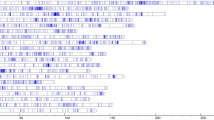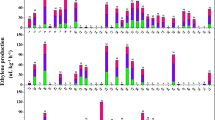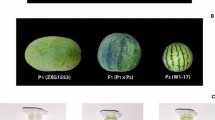Abstract
Lycopene content is an important factor for determining watermelon fruit quality. However, the low DNA polymorphism among cultivated watermelon (Citrullus lanatus) has hindered the ability to establish high quality genetic maps and study the quantitative trait loci (QTL) controlling the lycopene content trait. In this study, we successfully constructed a genetic map of watermelon to determine lycopene content and other horticultural fruit traits using a F2 population developed from a cross between the two lines of watermelon LSW-177 and Cream of Saskatchewan. The genetic map contained 16 linkage groups covering a total length of 2,039.5 cM, which included 37 SSRs (Simple Sequence Repeat) and 107 CAPSs (Cleaved Amplified Polymorphic Sequences), with all of the CAPS markers developed from high-throughput re-sequencing of data from this study. Three CAPS markers (WII04E07-33,WII04E07-37,WII04E07-40) caused the F2 population to perfectly co-segregate for each F2 population plants. We also obtained 12 QTLs for all of the traits measured. Only one QTL (LCYB4.1) was detected with a high value of trait variation (83.50 %) that related to lycopene content and mapped on Chromosome 4 between CAPS markers WII04E07-33 and WII04E07-40, which could nearly account for all of the differences in lycopene content between the two parental strains. In this study, we highlighted 2,458 CAPS loci that were suitable for primer design with a polymorphism of 48.9 %, which is approximately a 12-fold increase from previous studies. The present map and QTLs will facilitate future studies on determining lycopene content related genes and cloning watermelon genes, while also providing for useful markers for breeding for lycopene content.



Similar content being viewed by others
References
Bang H (2005) Environmental and genetic strategies to improve carotenoids and quality in watermelon. Dissertation for Ph D Degree at Texas A & M university U.S.A
Bang H, Kim S, Leskovar D, King S (2007) Development of a codominant CAPS marker for allelic selection between canary yellow and red watermelon based on SNP in lycopene β-cyclase (LCYB) gene. Mol Breed 20:63–72
Bang H, Davis AR, Kim S, Leskovar DI, King SR (2010) Flesh color inheritance and gene interactions among canary yellow, pale yellow, and red watermelon. J Am Soc Hortic Sci 135:362–368
Bo K, Song H, Shen J, Qian C, Staub JE, Simon PW, Lou Q, Chen J (2011) Inheritance and mapping of the ore gene controlling the quantity of β-carotene in cucumber (Cucumis sativus L.) endocarp. Mol Breed 30:335–344
Chen FQ, Foolad MR, Hyman J, St. Clair DA, Beelaman RB (1999) Mapping of QTLs for lycopene and other fruit traits in a Lycopersicon esculentum × L. pimpinellifolium cross and comparison of QTLs across tomato species. Mol Breed 5:283–299
Clayberg CD (1992) Interaction and linkage test of flesh color genes in Cucumis melo L. Cucurbit Genet Coop Rep 15:53
Cuevas HE, Staub JE, Simon PW, Zalapa JE, McCreight JD (2008) Mapping of genetic loci that regulate quantity of beta-carotene in fruit of US Western Shipping melon (Cucumis melo L.). Theor Appl Genet 117:1345–1359
Cuevas HE, Song H, Staub JE, Simon PW (2010) Inheritance of beta-carotene-associated flesh color in cucumber (Cucumis sativus L.) fruit. Euphytica 171:301–311
Danin-Poleg Y, Reis N, Tzuri G (2001) Development and characterization of microsatellite in Cucumis. Theor Appl Genet 102:61–72
Davis AR, Collins JK, Perkins Veazie PM, Levi A (2008) LSW-177 and LSW-194: red-fleshed watermelon lines with low-total soluble solids. HortScience 43:538–539
Fazio G, Staub JE, Chung SM (2002) Development and characterization of PCR markers in cucumber. HortScience 127:545–557
Femandez-Silva I, Eduardo I, Blanca J, Esteras C, Pico B, Nuez F, Arus P, Garcia-Mas J, Monforte AJ (2008) Bin mapping of genomic and EST-derived SSRs in melon (Cucumis melo L.). Theor Appl Genet 118:139–150
Feng D, Ling WH, Duan RD (2010) Lycopene suppresses LPS-induced NO and IL-6 production by inhibiting the activation of ERK, p38MAPK, and NF-k B in macrophages. Inflamm Res 59:115–121
Fernandez-Silva I, Eduardo I, Blanca J, Esteras C, Pico B, Nuez F, Arus P, Garcia-Mas J, Monforte AJ (2008) Bin mapping of genomic and EST-derived SSRs in melon (Cucumis melo L.). Theor Appl Genet 118:139–150
Gonzalo MJ, Oliver M, Garcia-Mas J, Monfort A, Dolcet-Sanjuan R, Katzir N, Arus P, Monforte AJ (2005) Simple-sequence repeat markers used in merging linkage maps of melon (Cucumis melo L.). Theor Appl Genet 110:802–811
Grassi S, Piro G, Lee JM, Zheng Y, Fei ZJ, Dalessandro G, Giovannoni JJ, Lenucci MS (2013) Comparative genomics reveals candidate carotenoid pathway regulators of ripening watermelon fruit. BMC Genomics 14:781
Guo SG, Xu Y, Zhang HY, Gong GY (2006) QTL analysis of soluble solids content in watermelon under different environments. Molecular Plant Breeding 4:393–398
Gusmini G, Wehner TC (2006) Qualitative inheritance of rind pattern and flesh color in watermelon. J Hered 97:177–185
Harel-Beja R, Tzuri G, Portnoy V, Lotan-Pompan M, Lev S, Cohen S, Dai N, Yeselson L, Meir A, Libhaber SE, Avisar E, Melame T, van Koert P, Verbakel H, Hofstede R, Volpin H, Oliver M, Fougedoire A, Stalh C, Fauve J, Copes B, Fei Z, Giovannoni J, Ori N, Lewinsohn E, Sherman A, Burger J, Tadmor Y, Schaffer AA, Katzir N (2010) A genetic map of melon highly enriched with fruit quality QTLs and EST markers, including sugar and carotenoid metabolism genes. Theor Appl Genet 121:511–533
Hashizume T, Shimamoto I, Hirai M (2003) Construction of a linkage map and QTL analysis of horticultural traits for watermelon [Citrullus lanatus (THUNB.) MATSUM & NAKAI] using RAPD, RFLP and ISSR markers. Theor Appl Genet 106:779–785
Henderson W, Scott G, Wehner T (1998) Interaction of flesh color genes in watermelon. J Hered 89:50–53
Henry RJ (2008) Plant genotyping II: SNP technology. CABI, Wallingford
Isaacson T (2002) Cloning of tangerine from tomato reveals a carotenoid isomerase essential for the production of beta-carotene and xanthophylls in plants. Plant Cell 14:333–342
Isaacson T, Ohad I, Beyer P, Hirschberg J (2004) Analysis in vitro of the enzyme CRTISO establishes a poly-cis-carotenoid biosynthesis pathway in plants. Plant Physiol 136:4246–4255
Joobeur T, Gusmini G, Zhang X, Levi A, Xu Y, Wehner TC, Oliver M, Dean AR (2006) Construction of a watermelon BAC library and identification of SSRs anchored to melon or Arabidopsis genomes. Theor Appl Genet 2:1553–1562
Kinkade MP, Foolad MR (2013) Validation and fine mapping of lyc12.1, a QTL for increased tomato fruit lycopene content. Theor Appl Genet 126:2163–2175
Kole C, Abbott AG (2008) Principles and practices of plant genomics, vol 1. Genome mapping Science Publishers, Enfield
Lambel S, Lanini B, Vivoda E, Fauve J, Wechter WP, Harris-Shultz KR, Massey L, Levi A (2014) A major QTL associated with Fusarium oxysporum race 1 resistance identified in genetic populations. Theor Appl Genet 127:2105–2115
Levi A, Thomas CE, Trebitsh T, Salman A, King J, Karalius J, Newman M, Reddy OUK, Xu Y, Zhang X (2006) An extended linkage map for watermelon based on SRAP, AFLP, SSR, ISSR, and RAPD markers. J Am Soc Hortic Sci 131:393–402
Li N, Zhang HY, Chen NL, Wang YJ, Xu Y, Gong GY, Guo SG (2008) Comparison of versatility and polymorphism of SSRs in the cucurbitaceae. Acta Agriculture Boreali-Sinica 23:1109–1114
Ling KS, Harris KR, Meyer JD, Levi A, Guner N, Wehner TC, Bendahmane A, Havey MJ (2009) Non-synonymous single nucleotide polymorphisms in the watermelon eIF4E gene are closely associated with resistance to Zucchini yellow mosaic virus. Theor Appl Genet 120:191–200
Liu QH, Wang HL, Zhou ZC (2009) Comparative study on lycopene content of different watermelon. North Hortic 8:44–46
Luan FS, Delannay I, Staub JE (2008) Chinese melon (Cucumis melo L.) diversity analyses provide strategies for germplasm curation, genetic improvement, and evidentiary support of domestication patterns. Euphytica 164:445–461
Monforte AJ, Oliver M, Gonzalo MJ, Alvarez JM, Dolcet-Sanjuan R, Arus P (2004) Identification of quantitative trait loci involved in fruit quality traits in melon (Cucumis melo L.). Theor Appl Genet 108:750–758
Morales M, Orjeda G, Nieto C, van Leeuwen H, Monfort A, Charpentier M, Caboche M, Arus P, Puigdomenech P, Aranda MA, Dogimont C, Bendahmane A, Garcia-Mas J (2005) A physical map covering the nsv locus that confers resistance to Melon necrotic spot virus in melon (Cucumis melo L.). Theor Appl Genet 111:914–922
Mortensen A, Skibsted LH, Sampson J, Rice-Evans C, Everett SA (1997) Comparative mechanisms and rates of free radical scavenging by carotenoid antioxidants. FEBS Lett 418:91–97
Navot N, Sarfatti M, Zamir D (1990) Linkage relationships of genes affecting bitterness and flesh color in watermelon. J Hered 81:162–165
Perin C, Hagen LS, Giovinazzo N, Besombes D, Dogimont C, Pitrat M (2002) Genetic control of fruit shape acts prior to anthesis in melon (Cucumis melo L.). Mol Genet Genom 266:933–941
Poole CF (1994) Genetics of cultivated cucurbits. J Hered 35:122–128
Ren Y, Zhao H, Kou QH, Jiang J, Guo SG, Zhang HY, Hou WJ, Zou XH, Sun HH, Gong GY, Levi A, Xu Y (2012) A High Resolution Genetic Map Anchoring Scaffolds of the Sequenced Watermelon Genome. PLoS ONE 7:e29453
Ren Y, McGregor C, Zhang Y, Gong GY, Zhang HY, Guo SG, Sun HH, Cai WT, Zhang J, Xu Y (2014) An integrated genetic map based on four mapping populations and quantitative trait loci associated with economically important traits in watermelon (Citrullus lanatus). BMC Plant Biol 14:33
Ronen G, Carmel-Goren L, Zamir D, Hirschberg J (2000) An alternative pathway to β-carotene formation in plant chromoplasts discovered by map-based cloning of Betaandold-goldcolor mutations in tomato. Proc Natl Acad Sci USA 97:11102–11107
Sandlin K, Prothro J, Heesacker A, Khalilian N, Okashah R, Xiang W, Bachlava E, Caldwell DG, Taylor CA, Seymour DK, White V, Chan E, Tolla G, White C, Safran D, Graham E, Knapp S, McGregor C (2012) Comparative mapping in watermelon [Citrullus lanatus (Thunb.) Matsum. et Nakai]. Theor Appl Genet 125:1603–1618
Shen D, Fang ZY, Li XX, Li QH, Cheng JQ, Song JP, Wang HP, Qiu Y (2011) Inheritance of fruit flesh color in Cucumis sativus L. J Plant Genet Resour 12:216–222
Shimotsuma M (1963) Cytogenetical studies in the genus Citrullus. VI. Inheritance of several characters in watermelons. Jpn J Breed 13:235–240
Silberstein L, Kovalski I, Brotman Y, Perin C, Dogimont C, Pitrat M, Klingler J, Thompson G, Portnoy V, Katzir N, Perl-Treves R (2003) Linkage map of Cucumis melo including phenotypic traits and sequence-characterized genes. Genome 46:761–773
Tezuka T, Waki K, Yashiro K, Kuzuya M, Ishikawa T, Takatsu Y, Miyagi M (2009) Construction of a linkage map and identification of DNA markers linked to Fom-1, a gene conferring resistance to Fusarium oxysporum f.sp. melonis race 2 in melon. Euphytica 168:177–188
Yi K, Xu XL, Lu XY, Xu Y, Xiao LT, Wang YJ, Kang G (2003) Construction of molecular genetic map of watermelon by SSR and ISSR technology. J Hunan Agric Univ (Nat Sci) 29:333–347
Yuan LP, Lu XQ, Liu WG, Zhao JS, Lu JS, Yan ZH, He N, Guan LY, Zhu HJ (2012) Measurement of lycopene contents in watermelon. China Cucurbits Veg 25:1–4
Zalapa JE, Staub JE, McCreight JD, Chung SM, Cuevas H (2007) Detection of QTL for yield-related traits using recombinant inbred lines derived from exotic and elite US Western Shipping melon germplasm. Theor Appl Genet 114:1185–1201
Zhang RB, Xu Y, Yi K, Zhang HY, Liu LG, Gong GY, Levi A (2004) A genetic linkage map for watermelon derived from recombinant inbred lines. J Am Soc Hortic Sci 129:237–243
Zhang F, Gong G, Wang Q, He H, Xu Y (2006) Analysis of watermelon quality structure. J Fruit Sci 23:266–269
Zhang H, Wang H, Guo S, Ren Y, Gong G, Weng Y, Xu Y (2011) Identification and validation of a core set of microsatellite markers for genetic diversity analysis in watermelon, Citrullus lanatus Thunb. Matsum. and Nakai. Euphytica 186:329–342
Acknowledgments
This research was supported by the National Nature Science Foundation of China (31272186). This work was also supported by the China Agriculture Research System (CARS-26-02).
Conflict of interest
The authors declare that there are no conflicts of interests.
Author information
Authors and Affiliations
Corresponding author
Rights and permissions
About this article
Cite this article
Liu, S., Gao, P., Wang, X. et al. Mapping of quantitative trait loci for lycopene content and fruit traits in Citrullus lanatus . Euphytica 202, 411–426 (2015). https://doi.org/10.1007/s10681-014-1308-9
Received:
Accepted:
Published:
Issue Date:
DOI: https://doi.org/10.1007/s10681-014-1308-9




